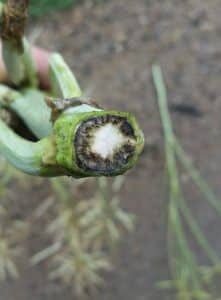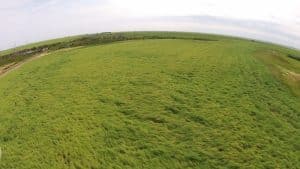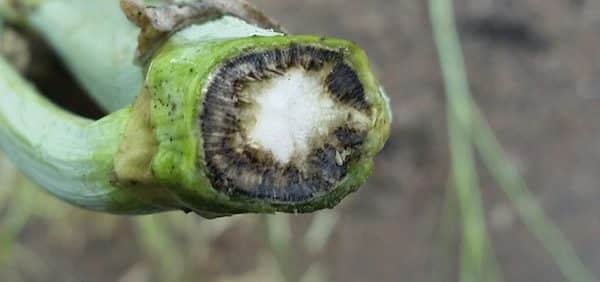Yield-robbing levels of disease will be easy to spot in canola fields now and through to harvest. This is a great time to start your pre-harvest disease scouting. Information gathered will show the effectiveness of this year’s disease management steps and help with decision-making for next year.


Three major stem diseases — blackleg, clubroot and sclerotinia stem rot — are more easily identified in the weeks leading up to harvest. Areas of the field with prematurely ripening plants and excessive lodging are signs that any one of these three diseases could be present. Here are tips to identify each:
Blackleg. Pull up diseased plants and use garden clippers to slice through the stem just below ground level. Look for blackened tissue inside the stem — a distinguishing feature of blackleg. If more than half the area of the stem is blackened, blackleg has likely reduced the yield of that plant.
Clubroot. Carefully dig up diseased-looking plants and look for galls on the roots. If clubroot is the reason for above-ground symptoms, the plant will have large galls at the base of the stem.
Sclerotinia stem rot. As the infected stem dries, it will become bleached or brown. Twist the infected stem. If it shreds apart, the disease is likely sclerotinia stem rot. Hard, black sclerotia bodies — similar in appearance to mouse droppings — found inside these bleached stems are a sure sign of sclerotinia stem rot.
Other diseases easier to identify in the weeks leading up to harvest are alternaria black spot and aster yellows. Alternaria tends to be more common in Polish canola and is rarely a problem in napus canola. Look for small black spots that move up the plant, eventually reaching the pods.
Obvious symptoms of aster yellows are the malformed bladder-like pods, which produce little to no yield. The disease can also result in normal looking pods that contain only a few misshapen seeds.
Also keep an eye out for verticillium wilt.
For extra help in diagnosing canola issues, use the Canola Diagnostic Tool at www.canoladiagnostictool.ca.
Random field surveys. In case you see us, Canola Council of Canada (CCC) agronomy staff will be checking random canola fields across the Prairies as part of a disease survey.
